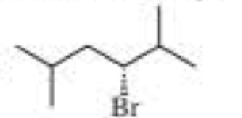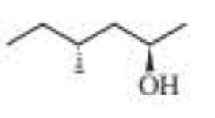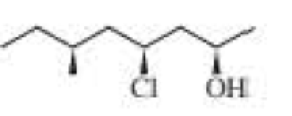
Pearson eText Organic Chemistry -- Instant Access (Pearson+)
8th Edition
ISBN: 9780135213711
Author: Paula Bruice
Publisher: PEARSON+
expand_more
expand_more
format_list_bulleted
Concept explainers
Textbook Question
Chapter 4, Problem 76P
Name the following:



Expert Solution & Answer
Want to see the full answer?
Check out a sample textbook solution
Students have asked these similar questions
Stuc X
ctclix
ALE X A ALE
אן
A ALEX
Lab
(195 X
Nut x
M Inb x
NU X
NUT X
Unt x +
→
C
www-awu.aleks.com/alekscgi/x/Isl.exe/10_u-lgNslkr7j8P3jH-IQ1g8NUi-mObKa_ZLx2twjEhK7mVG6PulJI006NcKTV37JxMpZuyrVCdQolLAKqp_7U3r1GUD3...
New Chrome available:
Naomi
Question 26 of 39 (4 points) | Question Attempt: 1 of Unlimited
Give the IUPAC name.
2,3-dimethylhexane
Part: 1/2
Part 2 of 2
Draw the skeletal structure of a constitutional isomer of the alkane above that contains a different number of carbons in its longest chain.
Skip Part
Check
Click and drag to start drawing a
structure.
3 Finance headline
Q Search
mwa
Harvard Intensifi...
X
Save For Later
00
dlo
HB
Submit Assignment
2025 McGraw Hill LLC. All Rights Reserved. Terms of Use | Privacy Center | Accessibility
a
9:11 PM
4/22/2025
Predict the product of this organic reaction:
+
NH2
HO
A
P+ H2O
Specifically, in the drawing area below draw the skeletal ("line") structure of P.
If there is no reasonable possibility for P, check the No answer box under the drawing area.
Click and drag to start drawing a
structure.
✓
个
Stuc X
ctclix ALE X A ALE × A ALE X
Lab x
(195 ×
Nut x M Inbx EF
目
→ C
www-awu.aleks.com/alekscgi/x/Isl.exe/10_u-IgNslkr7j8P3jH-IQ1g8NUi-mObKa_ZLx2twjEhK7mVG6PulJI006NcKTV37JxMpz
Chapter 12 HW
=
Question 27 of 39 (5 points) | Question Attempt: 1 of Unlimited
Part: 1/2
Part 2 of 2
Give the IUPAC name.
Check
3 50°F
Clear
©2025 McGraw Hill L
Q Search
webp
a
عالياك
Chapter 4 Solutions
Pearson eText Organic Chemistry -- Instant Access (Pearson+)
Ch. 4.1 - Prob. 2PCh. 4.1 - Prob. 3PCh. 4.1 - Prob. 4PCh. 4.1 - Prob. 5PCh. 4.1 - Which of the roll owing compounds have a dipole...Ch. 4.2 - Draw and label the E and Z isomers for each of the...Ch. 4.2 - Assign relative priorities to each set of...Ch. 4.2 - Tamoxifen slows the growth of some breast tumors...Ch. 4.2 - Prob. 10PCh. 4.2 - Name each of the following:
Ch. 4.2 - Draw the Z isomer of an alkene that has a CH3 and...Ch. 4.3 - Prob. 13PCh. 4.4 - Prob. 14PCh. 4.5 - Prob. 16PCh. 4.6 - Prob. 17PCh. 4.7 - Prob. 18PCh. 4.8 - Prob. 20PCh. 4.8 - Prob. 22PCh. 4.8 - Prob. 23PCh. 4.8 - Prob. 24PCh. 4.8 - Draw a perspective formula for each or the...Ch. 4.8 - Prob. 27PCh. 4.9 - Prob. 28PCh. 4.9 - What is the configuration of the following...Ch. 4.9 - Prob. 32PCh. 4.10 - Prob. 33PCh. 4.10 - (S)-(+)-Monosodium glutamate (MSG) is a flavor...Ch. 4.11 - Prob. 35PCh. 4.11 - Prob. 36PCh. 4.12 - Prob. 38PCh. 4.12 - Prob. 39PCh. 4.12 - The stereoisomer of cholesterol found in nature is...Ch. 4.12 - Prob. 41PCh. 4.13 - 1-Bromo-2-methylcyclopentane has four pairs of...Ch. 4.13 - Prob. 43PCh. 4.13 - Draw all possible stereoisomers for each of the...Ch. 4.13 - Prob. 45PCh. 4.13 - Of all the possible cyclooctanes that have one...Ch. 4.13 - Prob. 47PCh. 4.13 - Prob. 48PCh. 4.14 - Which of the following compounds has a...Ch. 4.14 - Draw all the stereoisomers for each of the...Ch. 4.15 - Prob. 52PCh. 4.15 - Name the isomers you drew in Problem 52.Ch. 4.15 - Chloramphenicol is a broad-spectrum antibiotic...Ch. 4.15 - Draw a perspective formula for each of the...Ch. 4.15 - Name the following:Ch. 4.15 - Prob. 57PCh. 4.15 - Prob. 59PCh. 4.15 - Convert the perspective formula to a skeletal...Ch. 4.15 - Prob. 62PCh. 4.16 - Prob. 63PCh. 4.17 - Limonene exists as two different stereoisomers....Ch. 4 - a. Draw three constitutional isomers with...Ch. 4 - Prob. 65PCh. 4 - Prob. 66PCh. 4 - Which of the following has an asymmetric center?...Ch. 4 - Prob. 68PCh. 4 - Prob. 69PCh. 4 - Prob. 70PCh. 4 - Prob. 71PCh. 4 - Assign relative priorities to each set of...Ch. 4 - Prob. 73PCh. 4 - Which of the following are optically active?Ch. 4 - Prob. 75PCh. 4 - Name the following:Ch. 4 - Which of the following has an achiral...Ch. 4 - Using skeletal structures, draw the stereoisomers...Ch. 4 - Prob. 79PCh. 4 - Citrate synthase, one of the enzymes in the series...Ch. 4 - Prob. 81PCh. 4 - Prob. 82PCh. 4 - Prob. 83PCh. 4 - Prob. 84PCh. 4 - Prob. 85PCh. 4 - Prob. 86PCh. 4 - Prob. 87PCh. 4 - Prob. 88PCh. 4 - Prob. 89PCh. 4 - a. Draw all the isomers with molecular formula...Ch. 4 - Prob. 91PCh. 4 - Prob. 92PCh. 4 - Draw structures for the following: a....Ch. 4 - For each of the following structures, draw the...Ch. 4 - Prob. 95PCh. 4 - Prob. 96PCh. 4 - Prob. 97PCh. 4 - a. Using the wedge-and-dash notation, draw the...Ch. 4 - Prob. 99PCh. 4 - Prob. 100PCh. 4 - Prob. 101PCh. 4 - a. Draw the two chair conformers for each of the...Ch. 4 - Prob. 103PCh. 4 - Is the following compound optically active?Ch. 4 - Prob. 105P
Knowledge Booster
Learn more about
Need a deep-dive on the concept behind this application? Look no further. Learn more about this topic, chemistry and related others by exploring similar questions and additional content below.Similar questions
- 个 Stuck x ctc xALE X A ALE × A ALE X Lab x (19: x - G www-awu.aleks.com/alekscgi/x/Isl.exe/10_u-lgNslkr7j8P3jH-1Q1g8NUi-mObka ZLx2twjEhK7mVG6PUUIO06 Chapter 12 HW 三 Question 26 of 39 (4 points) 1 Question Attempt: 1 of Unlimited Answer the following questions about the given alkane. Part: 0 / 2 Part 1 of 2 Give the IUPAC name. Skip Part 2 53°F Clear Check × Q Search hp hp 02arrow_forwardCalculate the equilibrium constant at 25.0 oC for the following equation. Cd(s) + Sn+2(aq) ↔Cd+2(aq) + Sn(s) Group of answer choices 3.11x104 1.95x1018 9.66x108 1.40x109arrow_forwardWhat is the pH at the cathode for the following cell written in line notation at 25.0 oC with a Ecell = -0.2749 V? Ni(s)|Ni+2(aq, 1.00 M)||H+1(aq, ?M)|H2(g, 1.00 atm)|Pt(s)arrow_forward
- Calculate Ecell for a hydrogen fuel cell at 95.0 oC using the following half-reactions with PH2 = 25.0 atm and PO2 = 25.0 atm. O2(g) + 4H+1(aq) + 4e-1 → 2H2O(l) Eo = 1.229 V 2H2(g) → 4H+1(aq) + 4e-1 Eo = 0.00 Varrow_forwardCalculate Ecell at 25.0 oC using the following half-reactions with [Ag+1] = 0.0100 M and [Sn+2] = 0.0200 M. Ag+1(aq) + 1e-1 Ag(s) Sn+2(aq) + 2e-1 Sn(s)arrow_forwardDone 18:19 www-awu.aleks.com Chapter 12 HW Question 27 of 39 (5 points) | Question Attempt: 1 of Unlimited .. LTE סוי 9 ✓ 20 ✓ 21 × 22 23 24 25 26 27 28 29 30 Answer the following questions about the given alkane. Part: 0 / 2 Part 1 of 2 Classify each carbon atom as a 1º, 2º, 3º, or 4°. Highlight in red any 1° carbons, highlight in blue any 2° carbons. highlight in green any 3° carbons, and leave any 4° carbons unhighlighted. Skip Part Check Save For Later © 2025 McGraw Hill LLC. All Rights Reserved. Terms of Use Privacy Center | Accessibility ☑ คarrow_forward
- < Done 19:22 www-awu.aleks.com Chapter 12 HW Question 4 of 39 (2 points) | Question Attempt: 5 of Unlimited : .. LTE סוי 1 ✓ 2 ✓ 3 = 4 ✓ 5 ✓ 6 ✓ 7 ✓ 8 ✓ 9 = 10 11 ✓ 12 Consider the molecule (CH3)2CHCH2CHCн for the following questions. Part 1 of 2 Which of the following molecules is/are constitutional isomer(s) to (CH3)2CHCH2CH2CH3? Check all that apply. Part 2 of 2 (CH3),C(CH2)2CH3 CH3 H,C-CH-CH-CH, CH 3 None of the above. ☑ Which of the following molecules is/are identical molecules to (CH3)2CHCH2CH2CH₁₂? Check all that apply. CH3 H,C-CH-CH₂-CH2-CH, CH3(CH2)2CH(CH3)2 CH2-CH2-CH3 HỌC-CH=CH, 乂 ☑ а None of the above Check Save For Later Submit Assignment © 2025 McGraw Hill LLC. All Rights Reserved. Terms of Use | Privacy Center Accessibilityarrow_forward18:11 LTE ا... US$50 off hotels is waiting for you Book now, hotels in Nashville are going fast QUTSLIVII 25 61 69 points) | QuestIVIT ALLēm... now Give the IUPAC name for each compound. Part 1 of 3 Part 2 of 3 X ☑ Х Check Save For Later Submit © 2025 McGraw Hill LLC. All Rights Reserved. TOMS CT US ...vacy Center | Accessibilityarrow_forwardDone 19:17 www-awu.aleks.com Chapter 12 HW Question 29 of 39 (6 points) | Question Attempt: 1 of Unlimited .III LTE סוי 27 28 = 29 30 31 32 = 33 34 35 Consider this structure. CH3CH2CH2 Part 1 of 3 3 CH2 CH2CH3 - C-CH2CH 3 H CH₂ Give the IUPAC name of this structure. 3-ethyl-3,4-dimethylheptane Part: 1/3 Part 2 of 3 Draw the skeletal structure. Skip Part < Check Click and drag to start drawing a structure. Save For Later Submit © 2025 McGraw Hill LLC. All Rights Reserved. Terms of Use | Privacy Center | Accessibility Хarrow_forward
- 18:57 .III LTE www-awu.aleks.com Chapter 12 HW Question 31 of 39 (8 points) | Question Attem... Give the IUPAC name of each compound. Part 1 of 4 Part 2 of 4 Х Х Check Save For Later Submit © 2025 McGraw Hill LLC. All Rights Reserved. TOMS OF US vacy Center | Accessibilityarrow_forwardWhat is the missing reactant in this organic reaction? CH3-C-CH2-NH2 + R - CH3 O: 0 CH3-N-CH2-C-NH-CH2-C-CH3 + H2O Specifically, in the drawing area below draw the condensed structure of R. If there is more than one reasonable answer, you can draw any one of them. If there is no reasonable answer, check the No answer box under the drawing area. Note for advanced students: you may assume no products other than those shown above are formed. Explanation Check Click anywhere to draw the first atom of your structure. C © 2025 McGraw Hill LLC. All Rights Reserved. Terms of Use | Privacy Center Accesarrow_forwardDone 18:17 • www-awu.aleks.com Chapter 12 HW Question 24 of 39 (4 points) | Question Attempt: 1 of Unlimited ▼ 20 ✓ 21 × 22 23 24 25 26 raw the structure corresponding to each IUPAC name. Part 1 of 2 .III LTE 22 27 28 סוי 29 29 3 A skeletal structure corresponding to the IUPAC name 3-ethyl-4-methylhexane. Part 2 of 2 Click and drag to start drawing a structure. A condensed structure corresponding to the IUPAC name 2,2,4- trimethylpentane. Click anywhere to draw the first atom of your structure. Check Save For Later Submit < Х ப: G © 2025 McGraw Hill LLC. All Rights Reserved. Terms of Use | Privacy Center | Accessibility : Garrow_forward
arrow_back_ios
SEE MORE QUESTIONS
arrow_forward_ios
Recommended textbooks for you

 Chemistry for Today: General, Organic, and Bioche...ChemistryISBN:9781305960060Author:Spencer L. Seager, Michael R. Slabaugh, Maren S. HansenPublisher:Cengage Learning
Chemistry for Today: General, Organic, and Bioche...ChemistryISBN:9781305960060Author:Spencer L. Seager, Michael R. Slabaugh, Maren S. HansenPublisher:Cengage Learning
 Chemistry: An Atoms First ApproachChemistryISBN:9781305079243Author:Steven S. Zumdahl, Susan A. ZumdahlPublisher:Cengage Learning
Chemistry: An Atoms First ApproachChemistryISBN:9781305079243Author:Steven S. Zumdahl, Susan A. ZumdahlPublisher:Cengage Learning ChemistryChemistryISBN:9781305957404Author:Steven S. Zumdahl, Susan A. Zumdahl, Donald J. DeCostePublisher:Cengage Learning
ChemistryChemistryISBN:9781305957404Author:Steven S. Zumdahl, Susan A. Zumdahl, Donald J. DeCostePublisher:Cengage Learning


Chemistry for Today: General, Organic, and Bioche...
Chemistry
ISBN:9781305960060
Author:Spencer L. Seager, Michael R. Slabaugh, Maren S. Hansen
Publisher:Cengage Learning


Chemistry: An Atoms First Approach
Chemistry
ISBN:9781305079243
Author:Steven S. Zumdahl, Susan A. Zumdahl
Publisher:Cengage Learning

Chemistry
Chemistry
ISBN:9781305957404
Author:Steven S. Zumdahl, Susan A. Zumdahl, Donald J. DeCoste
Publisher:Cengage Learning
Alcohols, Ethers, and Epoxides: Crash Course Organic Chemistry #24; Author: Crash Course;https://www.youtube.com/watch?v=j04zMFwDeDU;License: Standard YouTube License, CC-BY